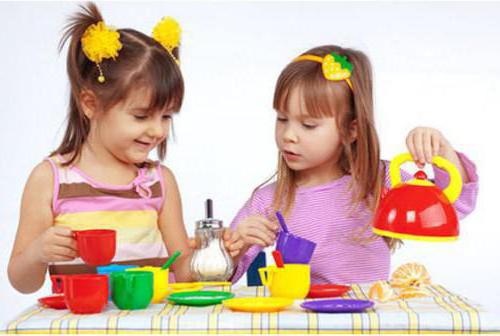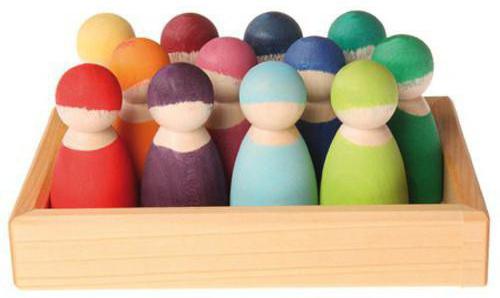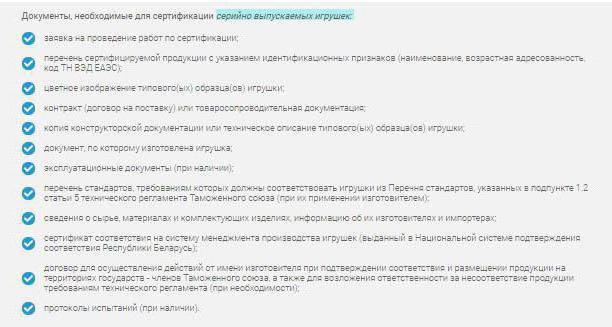If the degree of usefulness of a particular baby product is determined by adults who are responsible for the child, then special regulatory authorities should determine the safety.
What is a certificate for children's toys? How can I get it? And what should adults do when faced with low-quality children's goods?
Certificate for toys. Requirements, Features
A certificate for toys is a document that must be obtained by each manufacturer and seller of children's goods intended for the development of speech, mental and emotional functions of a child.
However, unfortunately, not all small private entrepreneurs want to provide a sample of their products for verification.
In addition, you should not lose sight of unreliable sellers selling toys of unknown origin (most often we are talking about goods from China). Competitive price, bright attractive appearance, as well as taking into account all modern trends, make such goods “tidbit” for adults and kids. How to protect your own child?

Toy classification
All children's toys subject to certification are divided among themselves according to the following series of signs:
- child's age (0-3, 5+, etc.);
- the appearance of the toy (cube, puzzle, rattle, machine);
- material used for its manufacture (rubber, plastic, wood);
- the purpose of the toy (sound development, development of fine motor skills, etc.);
- its device (mechanical, electrical, etc.).
In addition, some types of children's products are subject to additional requirements, for example, to obtain a certificate for toys for kindergarten, the manufacturer must pass:
- laboratory research;
- research on compliance with pedagogical standards.
What it is? In simple terms, the toy, which will subsequently be played by children of different ages within the pre-school educational institution, is obliged to develop faithful spiritual, intellectual and physical qualities in children.
Compliance testing is carried out by the Federal Expert Council of the Ministry of Education and Science of Russia or other state institutions that are created on the initiative of state educational authorities of the constituent entities of the Russian Federation.

Toys for children from 0 to 3 years
To begin with, it is worth noting that in 2012 the technical regulation of the Customs Union came into force under the name "On the safety of toys." That is, for about 5 years, all such products are required to have an appropriate certificate.
However, the smaller the child’s age, the more requirements are placed on a toy intended for use by very young children.
So, for example, those manufacturers who used to produce their products in the 0-3 year category will not receive certificates for children's toys:
- natural fur and skin (allergic reactions may occur);
- easily breaking or easily soaking materials (for example, glass, cardboard);
- recyclable materials;
- granules for packing less than 3 mm in size without special additional packaging.
In addition, in order to, for example, obtain certificates for wooden toys, the manufacturer will need to obtain a hygiene certificate.
The standard procedure for obtaining permits implies that this certificate is issued after receiving a sanitary-epidemiological report.
However, today a fairly large number of organizations offer toy manufacturers their services for simultaneously obtaining such permits. For this reason, talking about the procedure for obtaining certificates is not entirely true.
So, to obtain a hygiene certificate, children's products made of wood must:
- have well-crafted edges;
- Do not have paintwork.

Stuffed Toys
As in the case of wooden ones, obtaining a certificate for soft toys is associated with certain difficulties. So, for example, the material from which the soft-packable figure is made must correspond to the age norms of the child (this was already mentioned above).
In addition, soft toys must be tested for:
- packing water absorption;
- lack of chemicals of the 1st class;
- fire safety;
- organoleptic signs.
At the same time, manufacturers have the right to produce both frameless soft-stuffed products and toys with a skeleton frame.
Packaging
In order to obtain a certificate of conformity for children's toys, the manufacturer must responsibly treat not only the production of his goods, but also the process of creating packaging for him.
What must be indicated on the package?
- Product Name.
- Manufacturer or importer (country, address, contact phone number).
- Trademark (its absence is permissible).
- Age restrictions.
- Material used for manufacturing.
- Ways of storage, care.
- Date of issue.
- Lifetime.
If another country acts as a manufacturer or importer, then all labels on the package must be made in at least 2 languages (in the native language of the country of origin, if it is a member of the EAEU, and in Russian).

In addition, the package should contain an image of the toy and, in some cases, instructions for its use. However, these requirements are not mandatory, they rather affect the increase in consumer demand.
Verification Steps
On the territory of the Russian Federation, quality certificates for toys are issued after the following:
- applying for certification with the provision of all necessary documents;
- laboratory tests;
- registration of the certificate.

All children's toys are tested for safety in operation. Simply put, laboratory workers determine what the product consists of (materials, packing, accessories and other elements), study its design, chemical and microbiological properties.

The likelihood that the child may be injured by a toy (cut, swallow small parts) is also calculated. At the same time, everything is considered, even practically fictitious situations.
Based on the results of the inspection, a sanitary-epidemiological conclusion is issued.
Model certificate of conformity for toys
The Customs Union - mutually beneficial cooperation of certain states, giving the right to unhindered trade in equipment, goods and raw materials (upon receipt of the relevant document) to representatives of Russia, Armenia, Kazakhstan, Kyrgyzstan and Belarus.
For this reason, obtaining a certificate for such a product as children's toys is not just a necessary measure, it is also very beneficial.
A large Russian toy manufacturer, dreaming of working for export, will not be able to offer its goods to EAEU members until it receives a certificate of conformity.

Exceptions
There is a certain list of goods that do not require a certificate for toys, since such products are either not directly intended for children, or for them, but in the 14+ age group.
These include:
- artificial Christmas trees (+ all accessories for them, including Christmas toys);
- decorative dolls (category 14+);
- scale models for modeling, collecting (category 14+);
- equipment intended for playgrounds (including toys installed in public places and intended for general use);
- goods with heating elements (used in the educational process with mandatory control by adults);
- toys operating at a voltage of 24 V (+ battery chargers and steam engines);
- protective and swimming products (bicycle helmets, inflatable sleeves, etc.);
- flying toys launched with a rubber device;
- children's gaming machines;
- sports equipment;
- children's jewelry;
- exact copies of firearms and throwing weapons (bow, the length of which in the "working", stretched state exceeds the figure of 1.2 m, catapult, etc.);
- pneumatic weapons;
- goods made of latex or rubber, intended for sanitary purposes;
- big puzzles (from 500 puzzles);
- bicycles intended for use on public roads;
- TS with internal combustion engines (14+).
Poor quality products
A lot of people don’t even think about what to do if they accidentally find a seller selling toys without proper permissions (without a certificate for toys).
And it’s completely in vain, because if every person consciously begins to relate to the problem of counterfeit children's products, then its quantity in the Russian market will noticeably decrease.
So, if you find low-quality children's toys (dirty hands, emitting a sharp chemical smell), contact the Office of Rospotrebnadzor in your city. This can be done either by telephone on the “hot line” or by means of a written statement submitted to the supervision service in person or by e-mail.
Conclusion
So, to purchase something for a child from a seller who does not have a certificate for toys is extremely imprudent. However, even with an appropriate document, all things must be checked, because you should never exclude the fact of a fake certificate.
And if during the inspection of the toy no external damage to the material is found, traces of pollution are not visible, an unpleasant odor is not felt, and the packaging has the correct marking, such a product can be safely purchased.